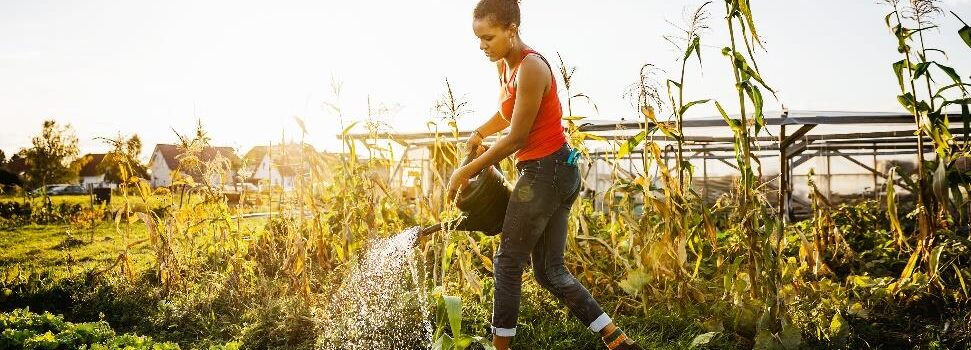Every year, new community gardens are created through the efforts of churches, hospitals, and countless other organizations and individuals. There are many benefits of gardening at a community site. It provides an opportunity for those who do not have the space or the desire to garden on their own. Such gardens create access allowing more people to grow their own food, which in turn, allows them to stretch their grocery dollars while enjoying fresh, healthy food at their fingertips. Plus, participating in a community garden brings the added bonus of having others nearby for gardening support, sharing tips, and sometimes produce and making new friends. Community gardening is as much about community as it is about gardening.
Community gardens come in many forms. There is the collective community garden where participants plant and tend one garden and all share in the harvest. The allotment style community garden is probably more widely known. This is where the garden is subdivided into individual plots that are often rented for a small fee to help pay garden expenses such as water. Plots in allotment gardens are individually planted, maintained, and harvested by the renter.
Community gardens can also be established with a particular objective in mind. Often community gardens are used to grow produce for food pantries or other food recipient organizations to help address food insecurity in the area. Community gardens can also be designed for a particular group like youth or seniors. So, if you want to start a community garden or join one, consider what type of garden would best suit your needs.
When planning a new community garden, to help get things organized it’s a good idea to form a team of individuals willing to serve on a leadership committee. These folks will participate in the planning of the garden. They will help identify needs, execute tasks as well as identify potential partners and supporters. It’s beneficial to have several people involved who can share the responsibilities of organizing and implementing this labor of love.
It is also important to choose a good site. Make sure it gets plenty of sun. Most vegetables need 6 or more hours of full sunlight a day. The site should be level and, ideally, have well-drained soil. It is recommended to have a soil test done to find out the fertility of the soil. Also, it is valuable to know the history of the site. What was it used for in the past? Was the site flooded or could there have been any use of the land that would have left behind toxins?
Another essential factor to keep in mind is how the site will be watered. Vegetables on average need about 1-1 ½ inches of water per week. Sometimes community garden sites lack a water source and require gardeners to tote water from home to water their plants. At one such garden I participated in there was a collective sigh of relief when the garden committee was able to install a water hydrant at the site. Hauling your own water is doable but having a nearby water source just makes it easier.
Start-up costs for a new community garden can include items such as site preparation, which often involves weed removal, tilling and possibly adding soil amendments. Fencing is often a consideration, which will give your garden a border and help keep critters out. Plus, most gardens will have some type of signage to let passersby know that this is a community garden site. Creating water access at the garden may also require some funds. If your site is hosted by an organization or business that has an available faucet, then maybe they will be willing to donate the water or work out a water stipend. If water is not readily available, installing a new faucet may be an option. At some gardens, I have seen a large water tank used to store water onsite.
Often when a group of people or an individual embarks on starting a community garden, they are pleasantly surprised at just how many folks in the community are willing to get involved. If you let people know how they can help, you may discover many donations of time, materials, or services from local businesses, individuals, organizations as well as support from the town or city. Also, don’t be shy about applying for grants as a way to raise funds to help cover your start-up costs.
You can find more information on how to start a community garden at the following sites:
•
The American Community Gardening Association website: www.communitygarden.org.
•
UW Madison Extension “Starting a Community Garden-How to put your plot on the path to success”: https://hort.extension.wisc.edu/articles/starting-community-garden-how-put-your-plot-path-success-0/
Question? Please feel free to contact me at margaret.murphy@wisc.edu or at 715-382-3253 or through your local County Extension office.
Gardening with a Community





